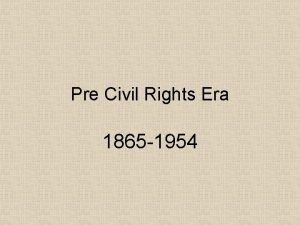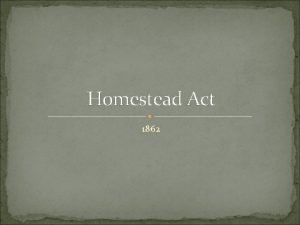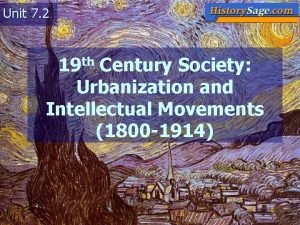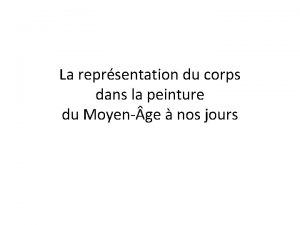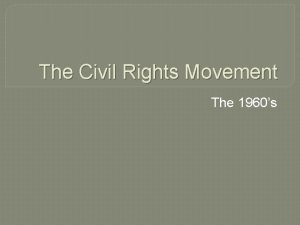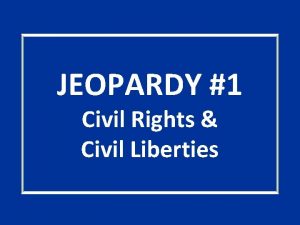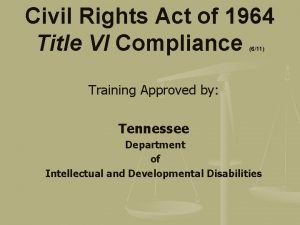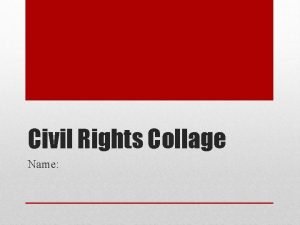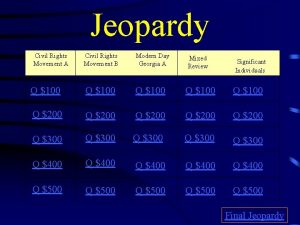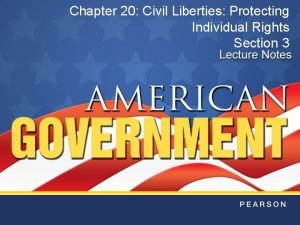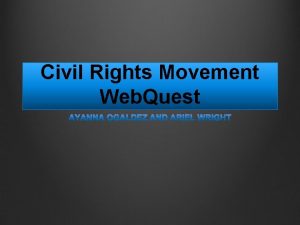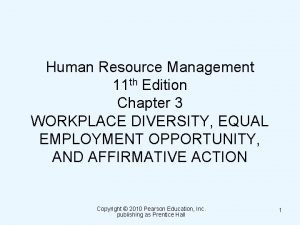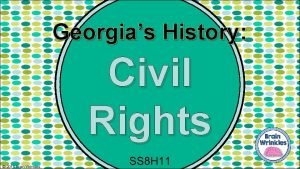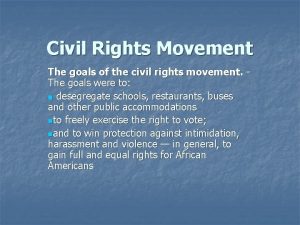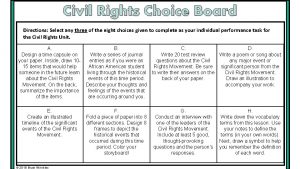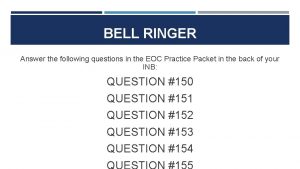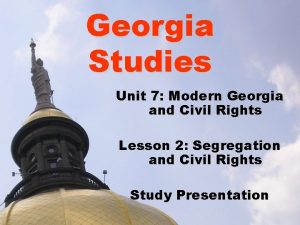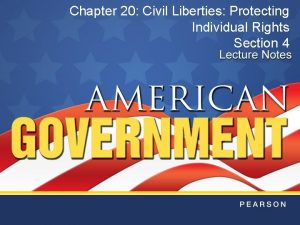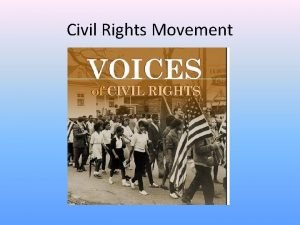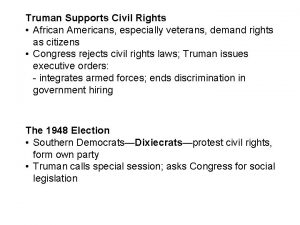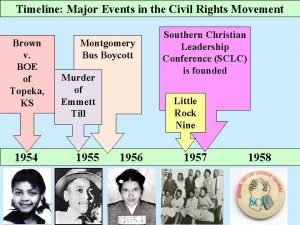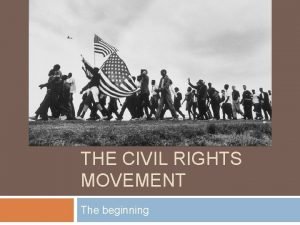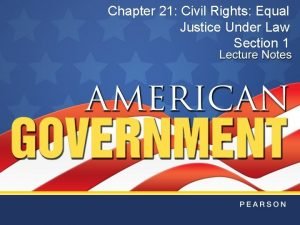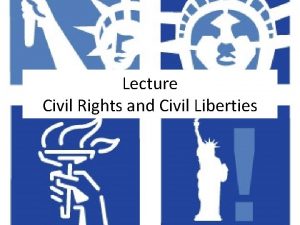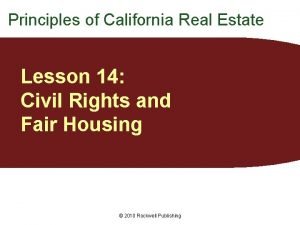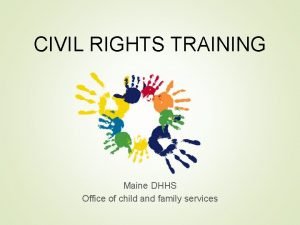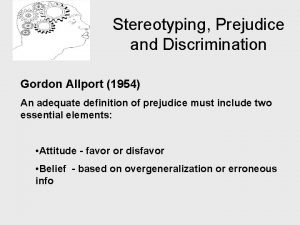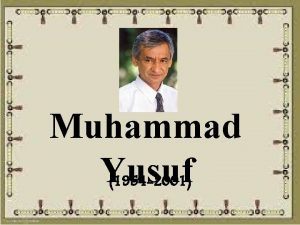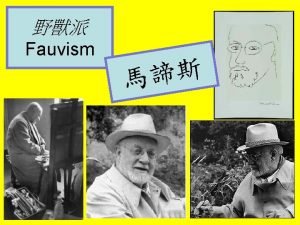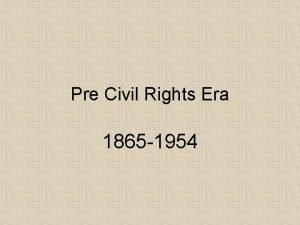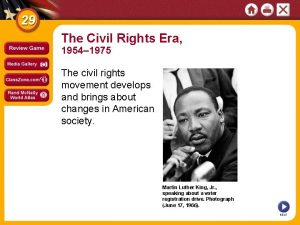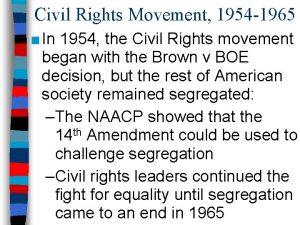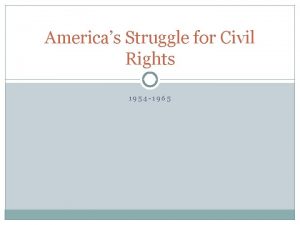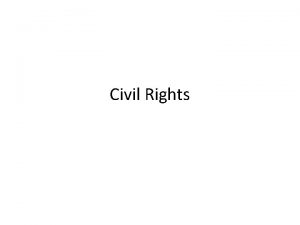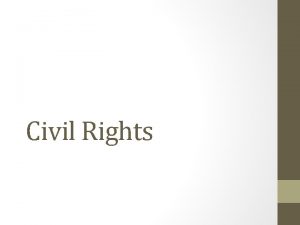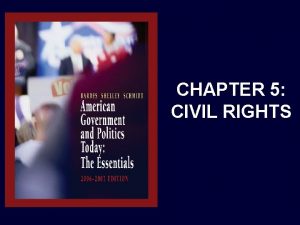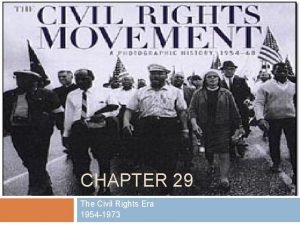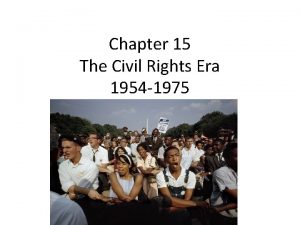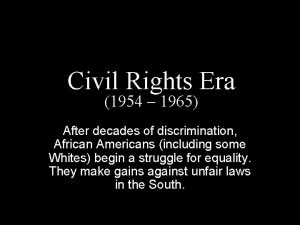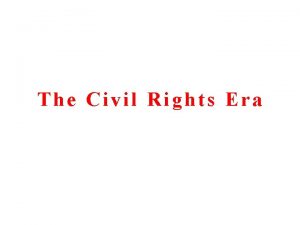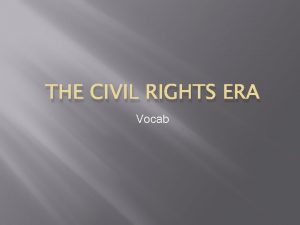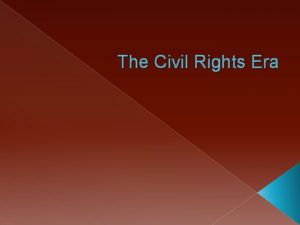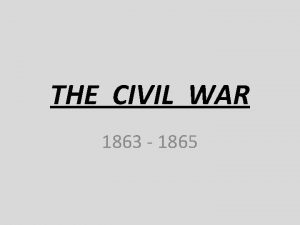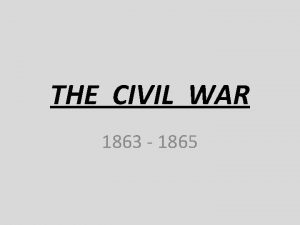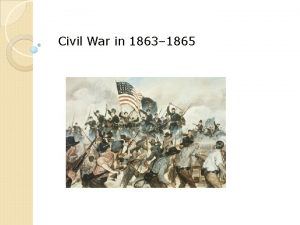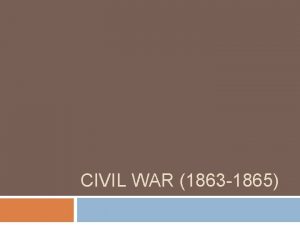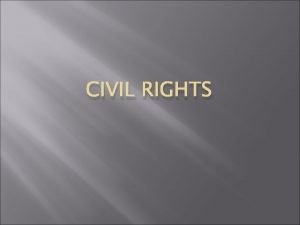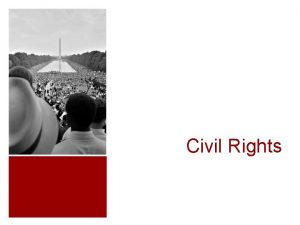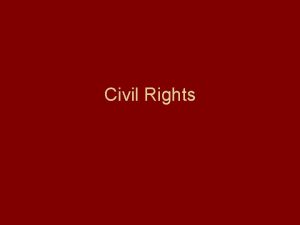Pre Civil Rights Era 1865 1954 1863 In




























































- Slides: 60

Pre Civil Rights Era 1865 -1954

1863 • In 1863 President Lincoln had issued the Emancipation Proclamation declaring all persons held as slaves within any State, shall be forever free.

But……. • The Emancipation Proclamation did not end slavery in the nation. • Lincoln knew that the Emancipation Proclamation would need a constitutional amendment to guarantee the abolishment of slavery. • There were 3 “reconstruction ammendments”

Post-Slavery (“Reconstruction”) • The Union army (north) defeated the Confederate army (south). The U. S. passed amendments banning slavery and saying *men* could vote regardless of their ethnicity. Many former slaves moved to cities in the North; those who couldn't often lived in conditions similar to slavery, renting parts of the former slavemaster's plantations (sharecropping).

January 31, 1865 13 th Amendment • Passed by Congress on January 31, 1865 abolished slavery in the United States.

1866 • The Civil Rights Act of 1866 granted citizenship and the same rights enjoyed by white citizens to all male persons in the United States "without distinction of race or color, or previous condition of slavery or involuntary servitude. "

Ku Klux Klan 1866 Those blacks that tried to vote were intimidated by the Ku Klux Klan (KKK), who would burn houses and murder just to prevent blacks from voting. The KKK was a terrorist organization.

The Ku Klux Klan beat, whipped, and murdered thousands, and intimidated tens of thousands of others from voting. Blacks often tried to fight back, but they were outnumbered and out gunned. While the main targets of Klan wrath were the political and social leaders of the black community, blacks could be murdered for almost any reason. Men, women, children, aged and crippled, were victims. A 103 -year-old woman was whipped, as was a completely paralyzed man.

14 th Ammendment 1868 Citizenship • In 1868, the 14 th Amendment to the Constitution of the United States granted citizenship and equal civil and legal rights to African Americans and slaves who had been emancipated after the American Civil War.

15 th Ammendment 1870 Voting Rights • The 15 th Amendment, granting African. American men the right to vote, was formally adopted into the U. S. Constitution on March 30, 1870.

1875 • African Americans were guaranteed the right to equal treatment in public and on public transportation. John Mercer Langston- helped draft the Act and was one of the early African Americans elected to Congress.

The Exodus of ‘ 79 • Thousands of African Americans migrate from the south to Kansas led by Benjamin Pap Singleton

1881 Tennessee Passes First Jim Crow Laws for trains Railroads Railways to provide equal but separate accommodations for the white and colored races.

1883 • The Supreme Court decided the Civil Rights Act was unconstitutional in 1883. • Laws were to be decided by states, not the federal government. John Marshall Harlan was • Individual states could now discriminate in any way the only member of the wanted against African Supreme Court who believed the Civil Rights Americans. Act should remain.

1890 Mississippi Poll Tax • Many Southern states created poll tax laws as a way to prevent eligible voters from voting. • These laws disfranchised African-American and poor whites. • This tax kept them from voting.

Literacy Test Laws were passed requiring a literacy test as well. Since most freed men couldn't read or write, blacks were prevented from voting.



Louisiana Grandfather Clause 1898 Whites in the South didn't have to pay or pass the literacy test because of "Grandfather Clause. ” If their grandfather could vote in 1867 then they could vote. However, no African Americans could vote in 1867 so they were disenfranchised.

1906 Plessy vs. Ferguson On June 7, 1892, 30 -year-old Homer Plessy was jailed for sitting in the "White" car of the East Louisiana Railroad.

1909 NAACP National Association for the Advancement of Colored People • Why was this organization founded (set up)?

In 1909, the country was still stunned from a race riot the year before in Springfield, Illinois, the city in which Lincoln had once lived. Eight blacks were killed and dozens injured as mobs of whites rampaged through the black community destroying homes, property, and businesses, forcing thousands to flee. After the riot, an Englishman by the name of William English Walling described how race prejudice was rampant in the North and called for "a powerful body of citizens to come to their aid. "

• The NAACP will " ensure the political, educational, social, and economic equality of rights of all persons and to eliminate racial hatred and racial discrimination. "

1910 -1920 The Great Migration • In the twentieth century, blacks started to move to the North as the train provided easy access to Chicago and other Northern cities. • When World War I began in Europe, and foreign workers could no longer emigrate to America, factories needed a new labor source. Hundreds of thousands of blacks migrated from the South to Chicago and other cities of the North. • The CHICAGO DEFENDER, the most influential black newspaper, encouraged blacks to leave. The paper held a vision of the North as the land of freedom, a dream that has been in the hearts of black men and women since slavery time -- many referred to the North as "The Promised Land"

Richard Wright 1908 – Young Richard Wright, who became an internationally acclaimed writer, remembered how the North kept hope alive during the dark days of his childhood in the deep South. "The North symbolized to me all that I had not felt or seen; it had no relation to what actually existed. Yet by imagining a place where everything is possible, it kept hope alive inside of me. "

Jackie Robinson 1947 • Jack Roosevelt Robinson was born in Cairo, Georgia in 1919 to a family of sharecroppers. His mother, Mallie Robinson, singlehandedly raised Jackie and her four other children. They were the only black family on their block, and the prejudice they encountered only strengthened their bond. From this humble beginning would grow the first baseball player to break Major League Baseball's color barrier that segregated the sport for more than 50 years.

1948 President Truman’s Executive Order • On July 26, 1948, President Truman issued Executive Order 9981 establishing equality of treatment and opportunity in the Armed Services.

The Civil Rights Movement 1954 -1968 Why was the Civil Rights Movement Necessary?

Plessy vs. Fergusson: Separate (segregation) but “equal” 1896 1954 What are some things we expect to be “equal” in this country? Equality Injustice



Separate – but equal? Yes or no?


Emmett Till

Mrs. Rosa Parks


Peaceful Demonstrations; Violent Reactions

Non-violent “sit in”




Segregation Integration

Segregation Map, 1954


Name of the famous and important Supreme Court Case that made the whole country INTEGRATE schools. Eight-year old Linda Brown who crossed railroad tracks to take a bus 21 blocks to a black school when there was a white school five blocks from her home.

Supreme Court "We conclude that in the field of public education the doctrine of 'separate but equal' has no place. Separate educational facilities are inherently unequal. " Brown v. Board of Education, 347 U. S. 483. 495 (May 17, 1954)



Integration Of Public schools

The Little Rock Nine (Arkansas)



Delivered August 28, 1963, at the Lincoln Memorial, Washington DC.

View from the Lincoln Memorial Washington Monument

President ohn F. Kennedy, Jr.


Victory! IVIL RIGHTS ACT OF 1964 By President Lyndon Johnson on July 2, 1964 Segregation was not allowed in: • public places • schools • employment (“Equal Opportunity Employers”) • Affirmative Action


Just after President Lyndon Johnson signed the Civil Rights Act

Malcolm X Rev. Martin Luther King, Jr.
 15 th ammendment
15 th ammendment During the free banking era between 1837 and 1863
During the free banking era between 1837 and 1863 Civil rights and civil liberties webquest
Civil rights and civil liberties webquest Edouard manet olympia 1863
Edouard manet olympia 1863 Hjälper sedan 1863
Hjälper sedan 1863 Where did impressionism originated
Where did impressionism originated Jeff wall morning cleaning
Jeff wall morning cleaning July 1-4 1863
July 1-4 1863 Homestead act of 1863
Homestead act of 1863 Nov 19 1863
Nov 19 1863 The stonebreakers
The stonebreakers Olympia, 1863
Olympia, 1863 Second industrial revolution
Second industrial revolution Edouard manet olympia 1863
Edouard manet olympia 1863 Constitucion de 1863
Constitucion de 1863 Manet, olympia, 1863
Manet, olympia, 1863 Civil rights sitins
Civil rights sitins Civil rights jeopardy
Civil rights jeopardy Title vi of the civil rights act of 1964
Title vi of the civil rights act of 1964 Civil rights collage
Civil rights collage Chapter 20 civil liberties protecting individual rights
Chapter 20 civil liberties protecting individual rights Civil rights movement jeopardy
Civil rights movement jeopardy Chapter 20 civil liberties protecting individual rights
Chapter 20 civil liberties protecting individual rights Civil rights movement webquest
Civil rights movement webquest Title vii of the civil rights act
Title vii of the civil rights act Civil rights cloze notes 1
Civil rights cloze notes 1 Goals of the civil rights movement
Goals of the civil rights movement Rosa parks mother
Rosa parks mother Civil rights movement essential questions
Civil rights movement essential questions Civil rights in child nutrition programs
Civil rights in child nutrition programs Civil rights choice board
Civil rights choice board Civil rights bell ringers
Civil rights bell ringers Unit 7 modern ga and civil rights
Unit 7 modern ga and civil rights Chapter 20 civil liberties protecting individual rights
Chapter 20 civil liberties protecting individual rights Civil rights movment
Civil rights movment Title vii of the civil rights act
Title vii of the civil rights act Civil rights cloze notes
Civil rights cloze notes Civil rights in child nutrition programs
Civil rights in child nutrition programs Postwar prosperity and civil rights
Postwar prosperity and civil rights Chapter 14 postwar prosperity and civil rights
Chapter 14 postwar prosperity and civil rights Civil rights movement vocabulary
Civil rights movement vocabulary Truman supports civil rights
Truman supports civil rights Usda civil rights training
Usda civil rights training Civil rights timeline of events
Civil rights timeline of events Cacfp civil rights
Cacfp civil rights The civil rights movement
The civil rights movement Civil rights training quiz answers
Civil rights training quiz answers Civil rights graphic organizer
Civil rights graphic organizer Chapter 21 civil rights equal justice under law
Chapter 21 civil rights equal justice under law Right to die
Right to die What did sncc accomplish and how
What did sncc accomplish and how Unruh civil rights act real estate
Unruh civil rights act real estate Characteristics of civil rights
Characteristics of civil rights Civil rights training certificate
Civil rights training certificate Magnétoscope 1954
Magnétoscope 1954 1954
1954 Fortran
Fortran Allport 1954
Allport 1954 Incident method
Incident method Muhammad yusuf maylida kimgadir
Muhammad yusuf maylida kimgadir Portrait of ln delectorskaya
Portrait of ln delectorskaya
